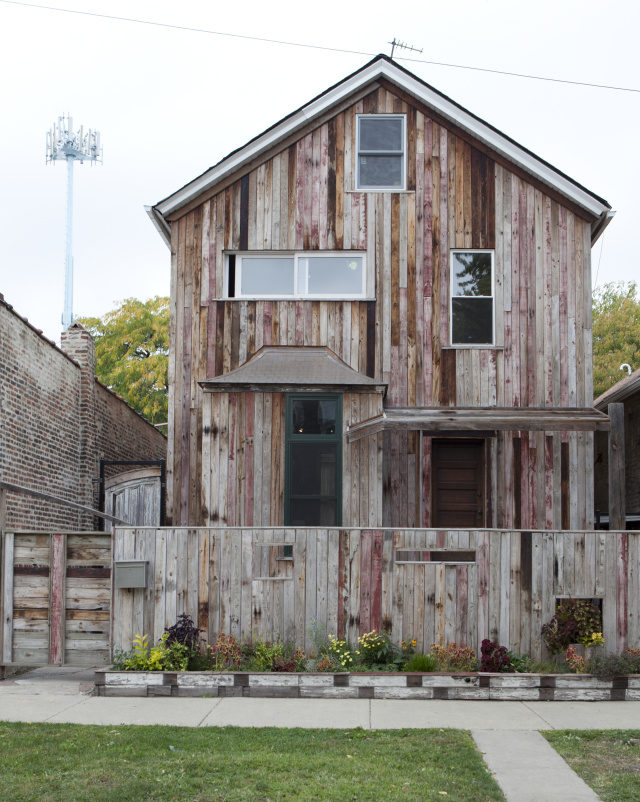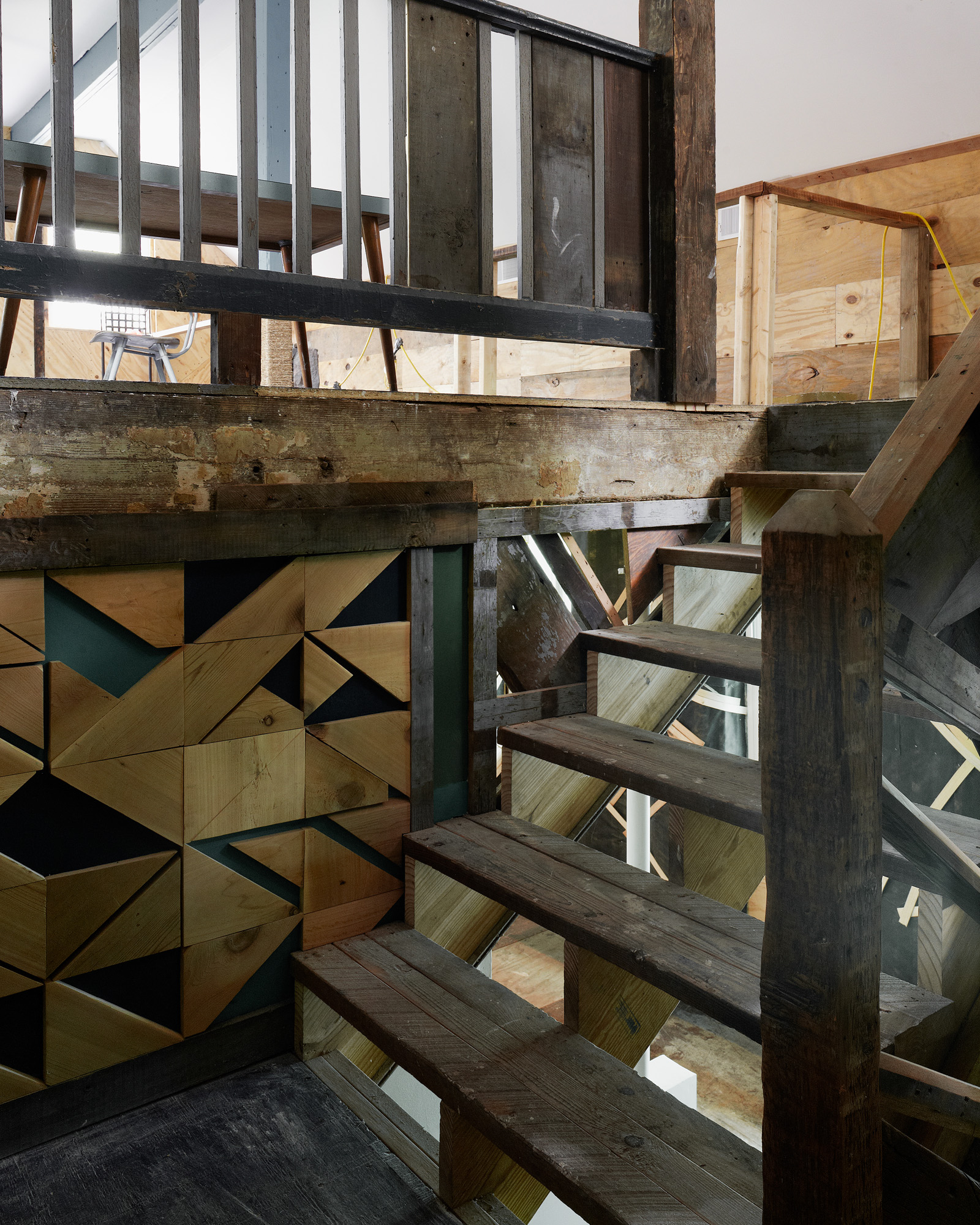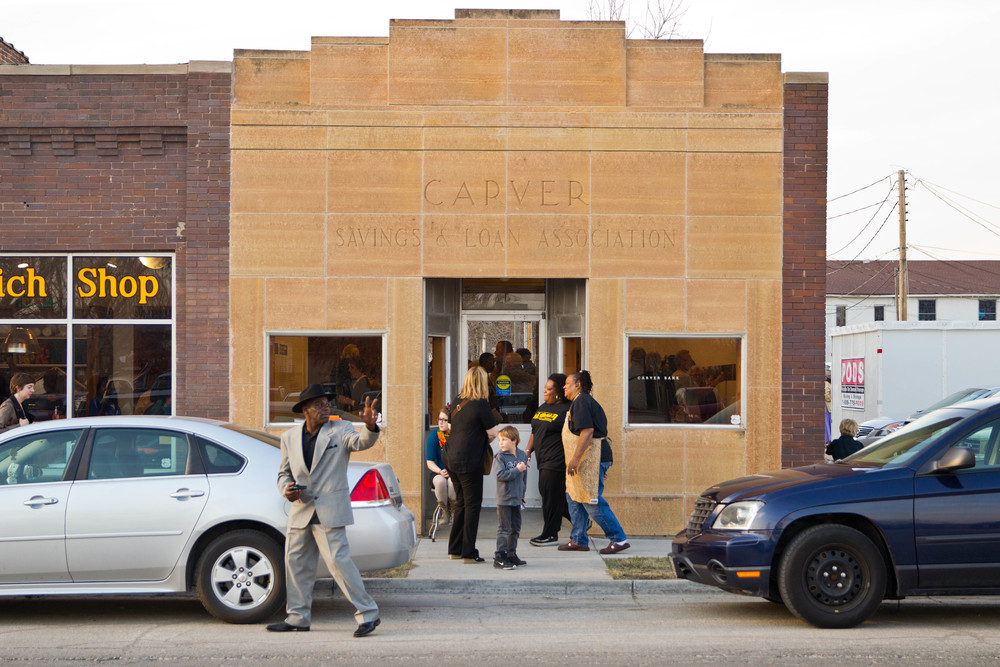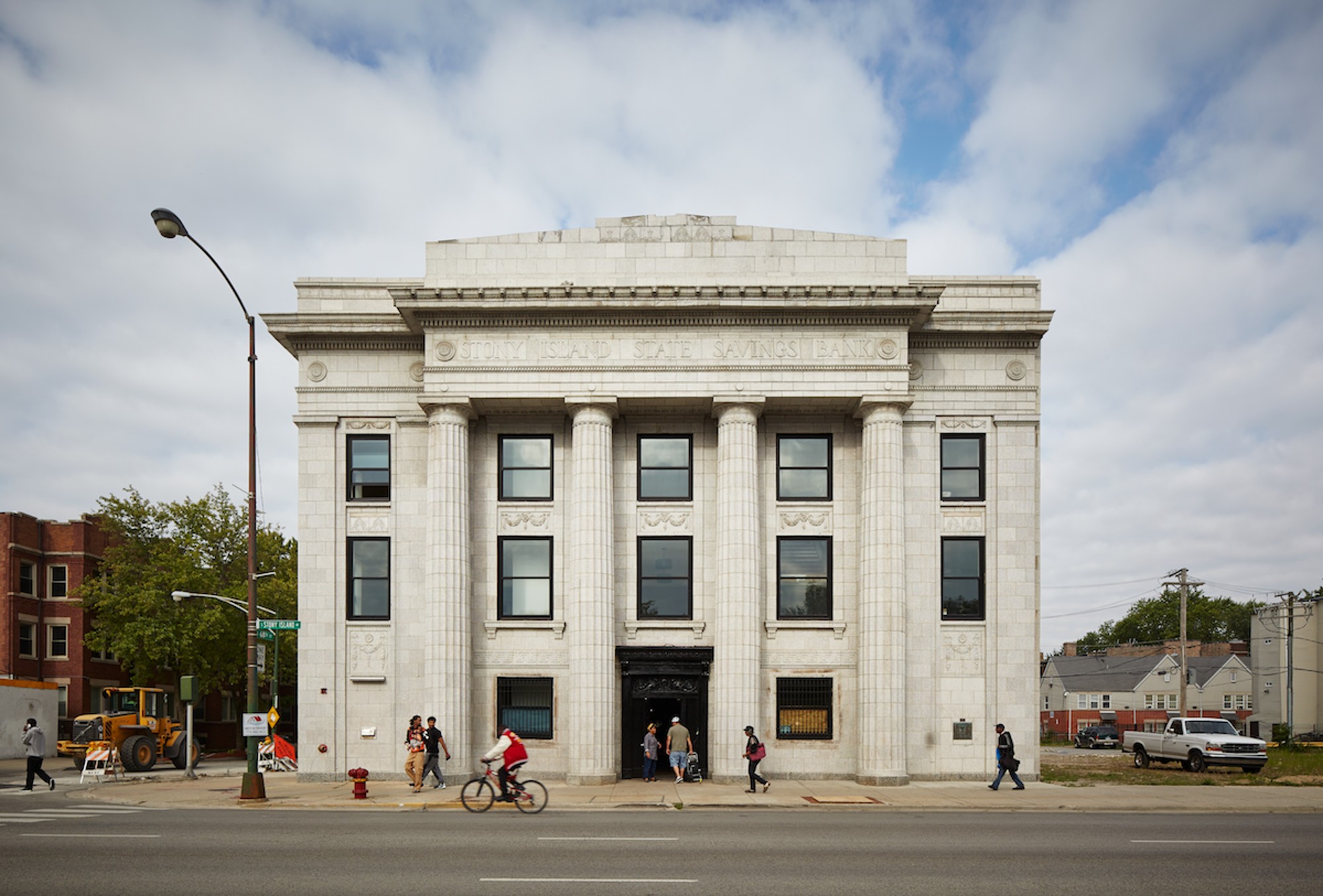Theaster Gates
Share:
Theaster Gates: I am spending more time talking about space than anything else.
Hesse McGraw: What else is there?
TG: Ideology, objects, music, clichés. But space feels best.
HM: Much of your work has been about creating space for those other things to come together in orchestrated ways, in places where that coming together might be unexpected. The spaces create torrents of surprise.
TG: The part that feels weird, though, is that there’s all of this examining and critique around what’s best for an artist to think about. What’s most efficient? What pays the most money? What is the ultimate ambition? How did we get so essential about everything? Artists no longer have the ability to just do the things that [they] want to do or love to do. The idea of space, because I can’t imagine it fully, because it escapes me, because it’s too big … it feels like it’s the right size.
HM: A larger issue that you’re confronting, or that the expanding scope of your practice is confronting, is actually a limiting perspective about who artists are and what artists might do and what artists have access to. From critical and curatorial perspectives, it is easier when, in a sense, we know what we’re going to get, but also, in a sense, when an artist’s work is identifiable, when the work is legible in a succinct and clear way.
TG: But that’s part of the problem.
HM: That is the problem. It’s a problem in relationship to other disciplines, even. The kind of fluidity that, let’s say, Rem Koolhaas has, or other design practitioners, or that even a filmmaker might have, is amazing. Those individuals are at the helm of a large team, realizing many different kinds of projects in many different kinds of places. We are resistant to artist-polymaths. Why doesn’t that latitude extend to contemporary artists?
TG: Because artists have museums and architects have the world. Because artists [make] dots on houses, like the Heidelberg Project, while planners rezone an area. That is, the form that we, as artists, get to play with, the form that we feel power over, the form that we’ve been given legal, governmental, or cultural agency over, differs. If the only form that we think we have the right to respond to is narrowly contested gestural form, then the world has succeeded at keeping the smartest motherfuckers busy twiddling their thumbs, navel-gazing, making gestural effects while more conventional thinkers are doing the other, more critical, more lucrative work that really needs creative, imaginative people to lead.
It’s true that, historically, breakthroughs have occurred in museum spaces and in gallery spaces. But it’s also true that some of the greatest contributions that have been made by artists have been made outside of [art] spaces.
Theaster Gates, Archive Library House, Dorchester Projects, Chicago, Illinois [courtesy of Theaster Gates / Rebuild Foundation]
Theaster Gates, Hyde Park Art House, St. Louis, Missouri [photo: Mike Sinclair; courtesy of Theaster Gates / Rebuild Foundation]
HM: I think too often we have been content to understand artists’ activities as presaging a bigger thing that will happen at a later time—the things that Gordon Matta-Clark or Chris Burden or Marina Abramovic did are things that Lady Gaga or others might make legible for a wider audience 35 years later. Something that’s been exciting about both the incredible rapidity of your projects and activities, but also in a sense their diversity, is that the work responds directly to the opportunity that is presented, whether that’s an opportunity in a museum or gallery or an opportunity on the block, an opportunity in St. Louis, an opportunity in Omaha. The reality in all cases is that each project is inventing its own system and finding ways to deploy that system in a context that is meaningful there.
TG: It’s funny that you use the words “responding to opportunity,” because I think that some people really believe that I’m going to these Midwestern cities because I’m getting paid. They think that the opportunity for me is similar to the way that a consultant would view an opportunity. The work is actually motivated by the challenges of the postindustrial city and the challenges of what [people may] continue to do when those industries leave. How do people socialize across the tracks? That set of challenges is just compelling enough to make me want to stay in multiple places long enough.
We have such a [limited] sense of what it means to live in a city that we imagine one could only live where one lives. There’s no radical thought around this idea, especially in this moment where you can be anywhere in the world, there’s a kind of conceptual globalism that has nothing to do with how much you’ve traveled. It has to do with how many places in the world one lives at the same time.
In this moment [when] it seems we could create new ways of imagining what home is, people are super-resistant to it. I’m attempting to open up space for myself. That is, I don’t want to live at home in one place. I also don’t imagine that my entire artistic career has to be shaped around one material, or one principal outcome, or one set of analytics, or one continued rubric.
It is not that I’m unable to focus on one thing. It’s the polyrhythmic, polysyncophonic challenge that gets me excited about dancing. It’s only when these things are colliding and clashing at the same time that the rhythm feels right. That is, I can never samba to a waltz.
In order for me to samba, in order for me to want to move my body in that way, I need a certain number of complexities to collide. It’s only in that moment when there’s Chicago, St. Louis, and Omaha happening or when there’s [simultaneously] Hong Kong, São Paulo, and Chicago to think about. Then it’s like, “Oh, there’s my rhythm. There’s my samba.” When I’m thinking about the White Cube show at the same time that I’m thinking about the end of dOCUMENTA, and Venice … it’s like, “Oh, this is how these three things become one thing and I can think about this one thing over time.”
But it requires a different sensibility around the idea of space. How much social or cultural space can we occupy at one time, how much time do we need to spend in a place in order for that to be a legitimate amount of time? The art feels like, in a way, I have to first wrangle the rhythm-makers together or find the right set of disparate circumstances in order to get to something that would feel like a key, a door, a hasp, and a lock [have] been fitted together—that there’s a thing that needs a key.
I want to live with a certain amount of complexity. It’s not until it gets to that place that I feel like there’s a project there.
Theaster Gates, Carver Bank, March 29, 2013 Opening, Omaha, Nebraska [photo:Chris Machian; courtesy of Theaster Gates / Rebuild Foundation and Bemis Center for Contemporary Arts]
HM: Is it possible to preserve complexity today?
TG: Or is complexity, by virtue of what it is, a moving target? It may be complex for a while, then it disappears, and then it reappears as something else that’s quite simple.
HM: It goes back to this problem—cultural entities, journalists, critics, et cetera, want to know what they’re going to get and want to be able to wrap their heads around a thing in advance.
So then, fundamentally, this situation where someone might say: “Theaster, can you come to our city and spread some of your place-making magic on our downtrodden place?”—presupposes that the activity is not complex and not challenging and doesn’t take a deep risk in terms of trespassing into a place.
TG: Right. I’ve come to believe that the work … we write off as a bureaucratic policy, or whatever—that work actually is a sacred work. It is a work that requires belief, not only by the individual charismatic, but also by a community of people who believe in the same thing. The thing that would make me cringe, when people would say, “Theaster, is this scalable?” or “How many cities are you going to do next year?” is that they approach it from a totally secular place, where they think that the rules are governed by [market principles and rationalism].
A big part of this work is that people put their lives on the line, and they put skin in the game. They put their belief systems to the test. They don’t just go to work every day and try to rebuild a new community. It’s not just that. When it is just that, you end up with ugly cultural districts, contrived, Disneyland‑like theme parks that don’t capture the heart of a cultural experience. They simply pad the pockets of certain people who brought business‑as‑usual, or culture‑as‑usual, to another place in the same way they brought it from the last city they were in. They put up their banners, their lampposts, their colored curbs, and their Hollywood foot imprints and other shit.
HM: And you leave your inhibitions in the minivan.
TG: You give your three‑year‑old a dollar to pass to the black guy playing the piano and say, “Thank you, you look like Little Richard. My mommy said you look like Little Richard.”
Can artists have a more strategic role in the way culture works? Could we be more intentional? Could we be trained more, differently, better, to not only think about our studios, but to also think about the rest of the world? Artists have a role if we want it.
HM: Exactly. The possibility that I see, in terms of realignment, is that we’ve misidentified artists as the extremists. In reality, the extremists are often our politicians, our corporate or sports icons: Donald Trump, Lance Armstrong, Anthony Weiner, on and on. These are the rogue figures in our culture. Artists work from a place of radical normalcy. What does it take for [artists] to be trusted to bring their pragmatism and ingenuity—core assets of their studio practice—to bear directly on the real challenges of the world, in real space?
TG: I’m wondering the same thing. When does it kick in? Even if we assume it can be taught, when does it kick in? Is it after an artist has attained a certain amount of public notoriety that we can set aside our museum‑based, meaning‑making [strategies] and take on [the larger role], as citizen-artists? When does it become okay to actually think about the world? The problem is when the actions cease to be artistic works, they start to fall flat, a politician’s act.
I do want to make good art, and good, for me, does include words like “meaningful.” Good art doesn’t happen without context for me. It’s not stripped to the material. It’s not stripped to a hand gesture. It’s not stripped of the accumulated layers of history that go along with the gesture, and the stroke, and the material.
Theaster Gates, Stony Island Art Bank, Chicago, Illinois [courtesy of Theaster Gates / Rebuild Foundation]
HM: What’s the next project?
TG: I have to restore the Stony Island bank. At first I don’t want the bank to have to be anything, but the lending bank that would give me the money to restore the old bank needs the bank to be completely planned in advance of the bank being built. It has to be fully planned because my bank has to pay the lending bank their money back.
HM: They don’t trust that the nothing can become something.
TG: They don’t trust that the nothing can be something. My two options are, don’t finance the bank, and celebrate the possibility of nothing, or get shareholders, go public, invite Google, bring in Applebee’s.
HM: Or become more persuasive about the nothing.
TG: Yes. The bank is going to be beautiful. Of course, it will have work to do, we’ll use the building to make meaning and as a platform. But, initially, I’m just excited that the bank, one of the last great architectural treasures of this neighborhood, which was going to be demolished, is still standing on the south side of Chicago. As a neighbor, I was able to stand up and say, “This building is important.” I’m not an historical society, and I’m not a big developer, and I’m not even versed in those languages of a certain kind of bureaucracy.
HM: That’s where the real and the symbolic bridge. Maybe it’s okay for the bank, or the reclamation of the bank, to be symbolic for a while.
TG: Maybe this is where the fun is for me—the space between the symbolic and the real.
This conversation originally appeared in ART PAPERS Volume 37, issue 3, May/June 2013, guest-edited by Erin Dziedzic.



